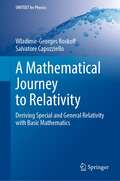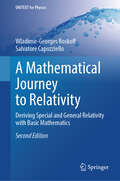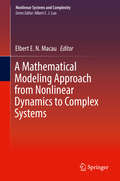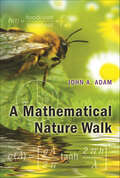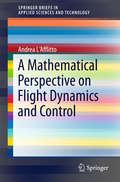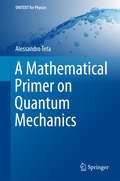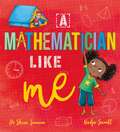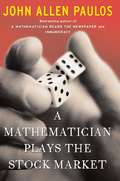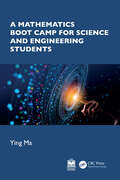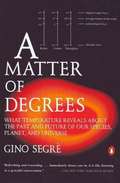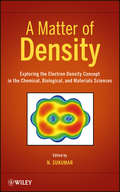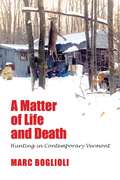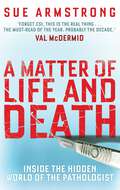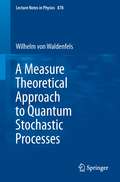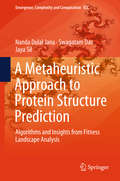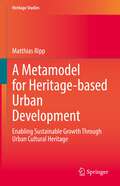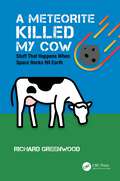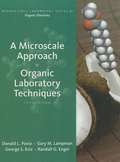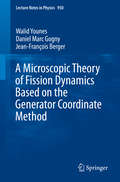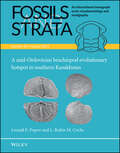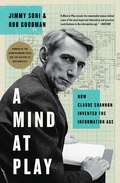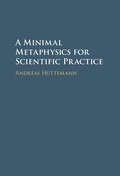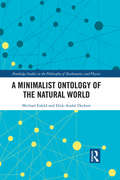- Table View
- List View
A Mathematical Journey to Relativity: Deriving Special and General Relativity with Basic Mathematics (UNITEXT for Physics)
by Wladimir-Georges Boskoff Salvatore CapozzielloThis book opens with an axiomatic description of Euclidean and non-Euclidean geometries. Euclidean geometry is the starting point to understand all other geometries and it is the cornerstone for our basic intuition of vector spaces. The generalization to non-Euclidean geometry is the following step to develop the language of Special and General Relativity. These theories are discussed starting from a full geometric point of view. Differential geometry is presented in the simplest way and it is applied to describe the physical world. The final result of this construction is deriving the Einstein field equations for gravitation and spacetime dynamics. Possible solutions, and their physical implications are also discussed: the Schwarzschild metric, the relativistic trajectory of planets, the deflection of light, the black holes, the cosmological solutions like de Sitter, Friedmann-Lemaître-Robertson-Walker, and Gödel ones. Some current problems like dark energy are also scketched. The book is self-contained and includes details of all proofs. It provides solutions or tips to solve problems and exercises. It is designed for undergraduate students and for all readers who want a first geometric approach to Special and General Relativity.
A Mathematical Journey to Relativity: Deriving Special and General Relativity with Basic Mathematics (UNITEXT for Physics)
by Wladimir-Georges Boskoff Salvatore CapozzielloThe 2nd edition of this textbook features more than 100 pages of new material, including four new chapters, as well as an improved discussion of differential geometry concepts and their applications. The textbook aims to provide a comprehensive geometric description of Special and General Relativity, starting from basic Euclidean geometry to more advanced non-Euclidean geometry and differential geometry. Readers will learn about the Schwarzschild metric, the relativistic trajectory of planets, the deflection of light, the black holes, and the cosmological solutions like de Sitter, Friedman-Lemaître-Robertson-Walker, and Gödel ones, as well as the implications of each of them for the observed physical world. In addition, the book provides step-by-step solutions to problems and exercises, making it an ideal introduction for undergraduate students and readers looking to gain a better understanding of Special and General Relativity. In this new edition, a wide discussion on metric-affine theories of gravity and equivalent formulations of General Relativity is reported. The aim is presenting also topics which could be useful for PhD students and researchers studying General Relativity from an advanced point of view.
A Mathematical Modeling Approach from Nonlinear Dynamics to Complex Systems (Nonlinear Systems and Complexity #22)
by Elbert E. MacauThis book collects recent developments in nonlinear and complex systems. It provides up-to-date theoretic developments and new techniques based on a nonlinear dynamical systems approach that can be used to model and understand complex behavior in nonlinear dynamical systems. It covers symmetry groups, conservation laws, risk reduction management, barriers in Hamiltonian systems, and synchronization and chaotic transient. Illustrating mathematical modeling applications to nonlinear physics and nonlinear engineering, the book is ideal for academic and industrial researchers concerned with machinery and controls, manufacturing, and controls.· Introduces new concepts for understanding and modeling complex systems;· Explains risk reduction management in complex systems;· Examines the symmetry group approach to understanding complex systems;· Illustrates the relation between transient chaos and crises.
A Mathematical Nature Walk
by John A. AdamHow heavy is that cloud? Why can you see farther in rain than in fog? Why are the droplets on that spider web spaced apart so evenly? If you have ever asked questions like these while outdoors, and wondered how you might figure out the answers, this is a book for you. An entertaining and informative collection of fascinating puzzles from the natural world around us, A Mathematical Nature Walk will delight anyone who loves nature or math or both. John Adam presents ninety-six questions about many common natural phenomena--and a few uncommon ones--and then shows how to answer them using mostly basic mathematics. Can you weigh a pumpkin just by carefully looking at it? Why can you see farther in rain than in fog? What causes the variations in the colors of butterfly wings, bird feathers, and oil slicks? And why are large haystacks prone to spontaneous combustion? These are just a few of the questions you'll find inside. Many of the problems are illustrated with photos and drawings, and the book also has answers, a glossary of terms, and a list of some of the patterns found in nature. About a quarter of the questions can be answered with arithmetic, and many of the rest require only precalculus. But regardless of math background, readers will learn from the informal descriptions of the problems and gain a new appreciation of the beauty of nature and the mathematics that lies behind it.
A Mathematical Perspective on Flight Dynamics and Control
by Andrea L'AfflittoThis brief presents several aspects of flight dynamics, which are usually omitted or briefly mentioned in textbooks, in a concise, self-contained, and rigorous manner. The kinematic and dynamic equations of an aircraft are derived starting from the notion of the derivative of a vector and then thoroughly analysed, interpreting their deep meaning from a mathematical standpoint and without relying on physical intuition. Moreover, some classic and advanced control design techniques are presented and illustrated with meaningful examples. Distinguishing features that characterize this brief include a definition of angular velocity, which leaves no room for ambiguities, an improvement on traditional definitions based on infinitesimal variations. Quaternion algebra, Euler parameters, and their role in capturing the dynamics of an aircraft are discussed in great detail. After having analyzed the longitudinal- and lateral-directional modes of an aircraft, the linear-quadratic regulator, the linear-quadratic Gaussian regulator, a state-feedback H-infinity optimal control scheme, and model reference adaptive control law are applied to aircraft control problems. To complete the brief, an appendix provides a compendium of the mathematical tools needed to comprehend the material presented in this brief and presents several advanced topics, such as the notion of semistability, the Smith–McMillan form of a transfer function, and the differentiation of complex functions: advanced control-theoretic ideas helpful in the analysis presented in the body of the brief. A Mathematical Perspective on Flight Dynamics and Control will give researchers and graduate students in aerospace control an alternative, mathematically rigorous means of approaching their subject.
A Mathematical Primer on Quantum Mechanics (UNITEXT for Physics)
by Alessandro TetaThis book offers a rigorous yet elementary approach to quantum mechanics that will meet the needs of Master’s-level Mathematics students and is equally suitable for Physics students who are interested in gaining a deeper understanding of the mathematical structure of the theory. Throughout the coverage, which is limited to single-particle quantum mechanics, the focus is on formulating theory and developing applications in a mathematically precise manner. Following a review of selected key concepts in classical physics and the historical background, the basic elements of the theory of operators in Hilbert spaces are presented and used to formulate the rules of quantum mechanics. The discussion then turns to free particles, harmonic oscillators, delta potential, and hydrogen atoms, providing rigorous proofs of the corresponding dynamical properties. Starting from an analysis of these applications, readers are subsequently introduced to more advanced topics such as the classical limit, scattering theory, and spectral analysis of Schrödinger operators. The main content is complemented by numerous exercises that stimulate interactive learning and help readers check their progress.
A Mathematician Like Me
by Dr Shini SomaraStriking illustrations and an empowering story combine to introduce young readers to the world of maths, creative thinking and problem-solving.Setting off on a camping adventure with her cousin, Aliyah soon discovers that numbers are everywhere, whether it's counting out money at the shops, planning trips on the train or even stargazing in a forest. As Aliyah solves some sums of her own, she learns about the brilliant mathematicians who have helped us understand our world. Soon she can't wait to become a maths whizz too!With pages encouraging kids to play maths games with their friends, this brilliant picture book written by engineer and TV presenter Dr Shini Somara unlocks a love of numbers and creative thinking, and celebrates women in STEM.Also available in the series:- A Scientist Like Me- A Coder Like Me- An Engineer Like Me
A Mathematician Plays The Stock Market
by John Allen PaulosIn A Mathematician Plays the Stock Market best-selling author John Allen Paulos demonstrates what the tools of mathematics can tell us about the vagaries of the stock market. Employing his trademark stories, vignettes, paradoxes, and puzzles (and even a film treatment), Paulos addresses every thinking reader's curiosity about the market: Is it efficient? Is it rational? Is there anything to technical analysis, fundamental analysis, and other supposedly time-tested methods of picking stocks? How can one quantify risk? What are the most common scams? What light do fractals, network theory, and common psychological foibles shed on investor behavior? Are there any approaches to investing that truly outperform the major indexes? Can a deeper knowledge of mathematics help beat the odds?All of these questions are explored with the engaging erudition that made Paulos's A Mathematician Reads the Newspaper and Innumeracy favorites with both armchair mathematicians and readers who want to think like them. Paulos also shares the cautionary tale of his own long and disastrous love affair with WorldCom. In the tradition of Burton Malkiel's A Random Walk Down Wall Street and Jeremy Siegel's Stocks for the Long Run, this wry and illuminating book is for anyone, investor or not, who follows the markets-or knows someone who does.
A Mathematician's Apology
by G. H. HardyG. H. Hardy was one of this century's finest mathematical thinkers, renowned among his contemporaries as a 'real mathematician … the purest of the pure'. He was also, as C. P. Snow recounts in his Foreword, 'unorthodox, eccentric, radical, ready to talk about anything'. This 'apology', written in 1940, offers a brilliant and engaging account of mathematics as very much more than a science; when it was first published, Graham Greene hailed it alongside Henry James's notebooks as 'the best account of what it was like to be a creative artist'. C. P. Snow's Foreword gives sympathetic and witty insights into Hardy's life, with its rich store of anecdotes concerning his collaboration with the brilliant Indian mathematician Ramanujan, his idiosyncrasies and his passion for cricket. This is a unique account of the fascination of mathematics and of one of its most compelling exponents in modern times.
A Mathematics Boot Camp for Science and Engineering Students
by Ying MaMany students have difficulty applying mathematical techniques to solve problems in science and engineering, even after completing Calculus I and II. Students who are beginning the core coursework in their field of study often need additional guidance on practicing, learning, and improving their problem-solving skills for application. The objectives of A Mathematics Boot Camp for Science and Engineering Students are to offer a solution to this issue and are specifically designed to address common errors in mathematical problem-solving for undergraduate science and engineering students. Teaches readers how to apply math skills as they transition to coursework in their chosen field of study Includes strategies and recommendations for quick improvement in problem-solving skills Emphasizes the physical meanings of the problem, which helps students develop a deep understanding of their field of study Features a broad range of example problems with detailed and easy-to-follow solutions for students to learn problem-solving techniques and additional exercise problems for further practice and improvement Bridges the gap between the knowledge of mathematical techniques and the ability to apply those techniques to solve real-world problems This concise and practical text offers "basic training" in mathematical problem-solving skills for undergraduate students in science and engineering disciplines. A Solutions Manual is available to qualifying adopting professors.
A Matter of Degrees
by Gino SegreIn a wonderful synthesis of science, history, and imagination, Gino Segrè, an internationally renowned theoretical physicist, embarks on a wide-ranging exploration of how the fundamental scientific concept of temperature is bound up with the very essence of both life and matter. Why is the internal temperature of most mammals fixed near 98.6°? How do geologists use temperature to track the history of our planet? Why is the quest for absolute zero and its quantum mechanical significance the key to understanding superconductivity? And what can we learn from neutrinos, the subatomic "messages from the sun" that may hold the key to understanding the birth-and death-of our solar system? In answering these and hundreds of other temperature-sensitive questions, Segrè presents an uncanny view of the world around us.
A Matter of Density
by N. SukumarThe origins and significance of electron density in the chemical, biological, and materials sciencesElectron density is one of the fundamental concepts underlying modern chemistry and one of the key determinants of molecular structure and stability. It is also the basic variable of density functional theory, which has made possible, in recent years, the application of the mathematical theory of quantum physics to chemical and biological systems.With an equal emphasis on computational and philosophical questions, A Matter of Density: Exploring the Electron Density Concept in the Chemical, Biological, and Materials Sciences addresses the foundations, analysis, and applications of this pivotal chemical concept. The first part of the book presents a coherent and logically connected treatment of the theoretical foundations of the electron density concept. Discussion includes the use of probabilities in statistical physics; the origins of quantum mechanics; the philosophical questions at the heart of quantum theory, like quantum entanglement; and methods for the experimental determination of electron density distributions.The remainder of the book deals with applications of the electron density concept in the chemical, biological, and materials sciences. Contributors offer insights on how a deep understanding of the origins of chemical reactivity can be gleaned from the concepts of density functional theory. Also discussed are the applications of electron density in molecular similarity analysis and electron density-derived molecular descriptors, such as electrostatic potentials and local ionization energies. This section concludes with some applications of modern density functional theory to surfaces and interfaces.An essential reference for students as well as quantum and computational chemists, physical chemists, and physicists, this book offers an unparalleled look at the development of the concept of electron density from its inception to its role in density functional theory, which led to the 1998 Nobel Prize in Chemistry.
A Matter of Life and Death: Hunting in Contemporary Vermont
by Marc BoglioliIn A Matter of Life and Death, anthropologist Marc Boglioli puts a human face on a group widely regarded as morally suspect, one that currently stands in the crossfire of America's so-called culture wars. Drawing on extensive ethnographic fieldwork in Addison County, Vermont, which took him from hunting camps and sporting goods stores to local bars and kitchen tables, Boglioli focuses on how contemporary hunters, women as well as men, understand their relationship to their prey. He shows how hunters' attitudes toward animals flow directly from the rural lifeways they have continued to maintain in the face of encroaching urban sensibilities. The result is a rare glimpse into a culture that experiences wild animals in a way that is at once violent, consumptive, and respectful, and that regards hunting as an enduring link to a vanishing past. It is a book that will challenge readers―hunters, non-hunters, and anti-hunters alike―to reconsider what constitutes a morally appropriate relationship with the non-human residents of this planet.
A Matter of Life and Death: Inside the Hidden World of the Pathologist
by Sue ArmstrongTrue tales of microscopic detective work that catches killers both human and pathogen: &“More fascinating than fiction. Forget CSI, this is the real thing&” (Val McDermid). A Matter of Life and Death profiles some of the world&’s most eminent and pioneering pathologists. This is a hidden world, yet one we will all inevitably encounter at some time in our lives, for pathology lies at the cornerstone of modern medicine. It is pathologists who are responsible for recognizing new diseases such as AIDS, SARS or bird flu, and for diagnosing which cancer a patient is suffering from. Beyond this, it is pathologists who must explain the cause of death at the autopsy table. A Matter of Life and Death tells fascinating stories of mysterious illnesses and miraculous scientific breakthroughs. But it is also crammed full of extraordinary characters - from the forensic anthropologist with his own Body Farm in Tennessee to the doctor who had a heart-and-lung transplant and ended up using her own lungs for research. &“If you&’re interested in criminal investigation, this is the must-read of the year. Probably of the decade.&” —Val McDermid, author of Insidious Intent
A Measure Theoretical Approach to Quantum Stochastic Processes (Lecture Notes in Physics #878)
by Wilhelm WaldenfelsThis monograph takes as starting point that abstract quantum stochastic processes can be understood as a quantum field theory in one space and in one time coordinate. As a result it is appropriate to represent operators as power series of creation and annihilation operators in normal-ordered form, which can be achieved using classical measure theory. Considering in detail four basic examples (e. g. a two-level atom coupled to a heat bath of oscillators), in each case the Hamiltonian of the associated one-parameter strongly continuous group is determined and the spectral decomposition is explicitly calculated in the form of generalized eigen-vectors. Advanced topics include the theory of the Hudson-Parthasarathy equation and the amplified oscillator problem. To that end, a chapter on white noise calculus has also been included.
A Metaheuristic Approach to Protein Structure Prediction: Algorithms And Insights From Fitness Landscape Analysis (Emergence, Complexity And Computation Ser. #31)
by Swagatam Das Nanda Dulal Jana Jaya SilThis book introduces characteristic features of the protein structure prediction (PSP) problem. It focuses on systematic selection and improvement of the most appropriate metaheuristic algorithm to solve the problem based on a fitness landscape analysis, rather than on the nature of the problem, which was the focus of methodologies in the past. Protein structure prediction is concerned with the question of how to determine the three-dimensional structure of a protein from its primary sequence. Recently a number of successful metaheuristic algorithms have been developed to determine the native structure, which plays an important role in medicine, drug design, and disease prediction. This interdisciplinary book consolidates the concepts most relevant to protein structure prediction (PSP) through global non-convex optimization. It is intended for graduate students from fields such as computer science, engineering, bioinformatics and as a reference for researchers and practitioners.
A Metamodel for Heritage-based Urban Development: Enabling Sustainable Growth Through Urban Cultural Heritage (Heritage Studies)
by Matthias RippThis book proposes a Metamodel for heritage-based urban development, based on urban morphology, governance theory, and the metamodeling concept of John P. Van Gigch. Building on international policies such as the 2011 Recommendation for Historic Urban Landscapes and the results of the 2016 Urban Habitat III Conference, cultural heritage is now regarded as a potential resource for sustainable urban development. While more and more evidence of the potential benefits of cultural heritage for sustainable development has been published, this book is the first to develop and design a Metamodel that can be universally applied in a wide variety of settings. The Metamodel was developed using grounded theory and design research methodology and is based on three successful case-models from European contexts. The book includes three application scenarios that elaborate how the metamodel can be used to design, evaluate, and improve processes where cultural heritage is a starting point for sustainable urban development.
A Meteorite Killed My Cow: Stuff That Happens When Space Rocks Hit Earth
by Richard GreenwoodMeteorites are generally considered to be bizarre and exotic space junk that you only ever come across in museums. But the reality is very different. Meteorites are generally harmless, with the exception of a cow in Venezuela and a few dinosaurs. Well, quite a few dinosaurs in fact! They are arriving on Earth every day, everywhere, in the form of fine dust. The result is that meteorites can be collected from the rooftops of houses everywhere. It’s not easy and you need to know what to look for. This book will help. Meteorites are the oldest rocks in our Solar System and contain grains that are even older. These space rocks provide science with the best available evidence concerning the origin and early evolution of the Solar System.This book introduces the reader to the fascinating and sometimes bizarre world of space rocks using a simple, clear layman-friendly style. It explains why they are so special and describes their main characteristics. The non-technical approach used throughout the book make it particularly accessible to the general public and it will be of interest to anyone looking to learn more about these cosmic visitors and the wealth of scientific information they contain.Features: Provides a concise introduction to the world of meteorites in an accessible and non-technical way Demonstrates how meteorites can be found locally and provides practical guidance on how to search for them! Emphasizes the human side of meteorites and how ordinary people can and do encounter meteorites in a wide variety of settings
A Microscale Approach to Organic Laboratory Techniques (Fifth Edition)
by Donald L. Pavia Gary M. Lampman George S. Kriz Randall G. EngelThis edition of the microscale lab book teaches students the techniques of organic chemistry. Many new up-to-date experiments that will demonstrate how organic chemistry is evolving are included in this edition.
A Microscopic Theory of Fission Dynamics Based on the Generator Coordinate Method (Lecture Notes in Physics #950)
by Walid Younes Daniel Marc Gogny Jean-François BergerThis book introduces a quantum-mechanical description of the nuclear fission process from an initial compound state to scission. Issues like the relevant degrees of freedom throughout the process, the way of coupling collective and intrinsic degrees during the fission process, and how a nucleus divides into two separate daughters in a quantum-mechanical description where its wave function can be non-local, are currently being investigated through a variety of theoretical, computational, and experimental techniques. <p><p> The term “microscopic” in this context refers to an approach that starts from protons, neutrons, and an effective (i.e., in-medium) interaction between them. The form of this interaction is inspired by more fundamental theories of nuclear matter, but still contains parameters that have to be adjusted to data. Thus, this microscopic approach is far from complete, but sufficient progress has been made to warrant taking stock of what has been accomplished so far. <p> The aim is to provide, in a pedagogical and comprehensive manner, one specific approach to the fission problem, originally developed at the CEA Bruyères-le-Châtel Laboratory in France. Intended as a reference for advanced graduate students and researchers in fission theory as well as for practitioners in the field, it includes illustrative examples throughout the text to make it easier for the reader to understand, implement, and verify the formalism presented.
A Mid-Ordovician Brachiopod Evolutionary Hotspot in Southern Kazakhstan (Fossils and Strata Monograph Series #66)
by L. Robin Cocks Leonid E. PopovDiscover a crucial period and location in the study of brachiopod evolution Part of the Fossils and Strata Monograph Series, A Mid-Ordovician Brachiopod Evolutionary Hotspot in Southern Kazakhstan offers readers an illuminating and engrossing look at brachiopods from the mid-Ordovician period in Southern Kazakhstan. The book explores the geological setting, brachiopod associations, and their implications for biodiversity. It also considers specific localities of interest, systematic paleontology, and provides over two dozen instructive figures and illustrations.
A Mind at Play: How Claude Shannon Invented the Information Age
by Jimmy Soni Rob GoodmanWinner of the Neumann Prize for the History of Mathematics "We owe Claude Shannon a lot, and Soni & Goodman&’s book takes a big first step in paying that debt." —San Francisco Review of Books "Soni and Goodman are at their best when they invoke the wonder an idea can instill. They summon the right level of awe while stopping short of hyperbole." —Financial Times "Jimmy Soni and Rob Goodman make a convincing case for their subtitle while reminding us that Shannon never made this claim himself." —The Wall Street Journal &“A charming account of one of the twentieth century&’s most distinguished scientists…Readers will enjoy this portrait of a modern-day Da Vinci.&” —FortuneIn their second collaboration, biographers Jimmy Soni and Rob Goodman present the story of Claude Shannon—one of the foremost intellects of the twentieth century and the architect of the Information Age, whose insights stand behind every computer built, email sent, video streamed, and webpage loaded. Claude Shannon was a groundbreaking polymath, a brilliant tinkerer, and a digital pioneer. He constructed the first wearable computer, outfoxed Vegas casinos, and built juggling robots. He also wrote the seminal text of the digital revolution, which has been called &“the Magna Carta of the Information Age.&” In this elegantly written, exhaustively researched biography, Soni and Goodman reveal Claude Shannon&’s full story for the first time. With unique access to Shannon&’s family and friends, A Mind at Play brings this singular innovator and always playful genius to life.
A Minimal Metaphysics for Scientific Practice
by Andreas HüttemannWhat are the metaphysical commitments which best 'make sense' of our scientific practice (rather than our scientific theories)? In this book, Andreas Hüttemann provides a minimal metaphysics for scientific practice, i.e. a metaphysics that refrains from postulating any structure that is explanatorily irrelevant. Hüttemann closely analyses paradigmatic aspects of scientific practice, such as prediction, explanation and manipulation, to consider the questions whether and (if so) what metaphysical presuppositions best account for these practices. He looks at the role which scientific generalisation (laws of nature) play in predicting, testing, and explaining the behaviour of systems. He also develops a theory of causation in terms of quasi-inertial processes and interfering factors, and he proposes an account of reductive practices that makes minimal metaphysical assumptions. His book will be valuable for scholars and advanced students working in both philosophy of science and metaphysics.
A Minimalist Ontology of the Natural World (Routledge Studies in the Philosophy of Mathematics and Physics)
by Michael Esfeld Dirk-Andre DeckertThis book seeks to work out which commitments are minimally sufficient to obtain an ontology of the natural world that matches all of today’s well-established physical theories. We propose an ontology of the natural world that is defined only by two axioms: (1) There are distance relations that individuate simple objects, namely matter points. (2) The matter points are permanent, with the distances between them changing. Everything else comes in as a means to represent the change in the distance relations in a manner that is both as simple and as informative as possible. The book works this minimalist ontology out in philosophical as well as mathematical terms and shows how one can understand classical mechanics, quantum field theory and relativistic physics on the basis of this ontology. Along the way, we seek to achieve four subsidiary aims: (a) to make a case for a holistic individuation of the basic objects (ontic structural realism); (b) to work out a new version of Humeanism, dubbed Super-Humeanism, that does without natural properties; (c) to set out an ontology of quantum physics that is an alternative to quantum state realism and that avoids any ontological dualism of particles and fields; (d) to vindicate a relationalist ontology based on point objects also in the domain of relativistic physics.
A Missing Link in Cybernetics: Logic and Continuity (IFSR International Series in Systems Science and Systems Engineering #26)
by Alex M. AndrewThe text begins by reviewing the origins and aims of cybernetics with particular reference to Warren McCulloch's declared lifetime quest of "understanding man's understanding". It is shown that continuous systems can undergo complex self-organization, but a need for classification of situations becomes apparent and can be seen as the evolutionary beginning of concept-based processing. Possibilities for complex self-organization are emphasized by discussion of a general principle that has been termed significance feedback, of which backpropagation of errors in neural nets is a special case. It is also noted that continuous measures come to be associated with processing that is essentially concept-based, as acknowledged in Marvin Minsky's reference to heuristic connection between problems, and the associated basic learning heuristic of Minsky and Selfridge. This reappearance of continuity, along with observations on the multi-layer structure of intelligent systems, supports a potentially valuable view of intelligence as having a fractal nature. This is such that structures at a complex level, interpreted in terms of these emergent measures, reflect others at a simpler level. Implications for neuroscience and Artificial Intelligence are also examined. The book presents unconventional and challenging viewpoints that will be of interest to researchers in AI, psychology, cybernetics and systems science, and should help promote further research.
